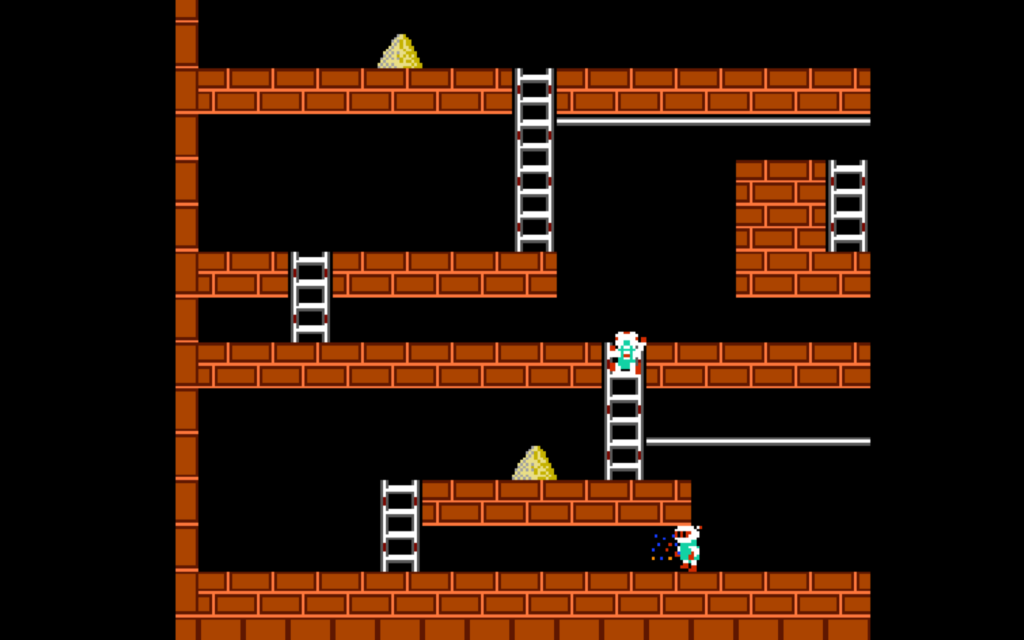By modern standards, Lode Runner, a game first released in 1983 by Broderbund, can seem simple. Its design, mechanics, and story (or lack thereof), have become so standard to game design that when revisiting the original, it is easy to take its innovations for granted. However, Lode Runner remains endlessly playable, and serves as a shift in the relationship between games, their designers, and their players, introducing the level editor to let players change the game itself.
The gameplay itself is quite straightforward: the player must climb up and down ladders to move around a level, avoiding the guards that chase them and collecting sacks of gold. To reach the the next level, the player must simply collect all the gold and reach the top of the screen. When played, it is more-or-less a traditional 2D platformer.
However, even during gameplay, mechanics exist for the player to influence the level’s setup: the player is able to dig temporary holes, trapping the guards (and possibly themselves). While putting the game in the digging game genre, it also hints with its mechanics at a breakdown between the strict roles of game developer and player. While simple on a surface level, playing the game quickly becomes immersive. The lack of complexity makes it easy for someone unfamiliar to jump right in. Thus, the focus isn’t on learning technical skills, but rather working through puzzles and developing strategies.

Beyond gameplay, what makes Lode Runner so notable is the ability it gives players to design their own levels through the introduction of a level editor. Lode Runner’s level editor, one of the first of its kind, allows the player to manipulate the platforms and create new designs. While video games were formerly limited to arcades, where little change was possible, Lode Runner demonstrated the potential of the player as an active participant in determining gameplay and increasing the game’s playability
An important aspect of this level editor is how it relates to the game itself: in such a way, it actually utilizes the less complex nature of the game, instead giving flexibility for those designing levels to use the straightforward and basic mechanics provided and letting them invent new ways of interactivity. They can use the basic language of the game to create their own puzzles, challenging whoever plays to think of a different aspect than initially provided. While I played around with the level editor in the emulator I was using, I found myself thinking about lessons learned in this class about mechanics and rules. When using the editor, the game purposefully pushes the player to think like the designer in order to come up with the right balance between fun and challenging.
A key part in reviewing Lode Runner is understanding how these new features actually changed players’ interactions with the game. While it’s one thing to load up an NES emulator and play through the game, what makes Lode Runner special is the community between players that it fosters, which unfortunately, is difficult to replicate when you’re alone. Instead, the first thing I did when starting to write this review was call up my dad, who played the game when he and his friends were in high school. He described how new levels were physically shared and passed between friends (I honestly find it difficult to imagine this pre-internet era). This led to a sense of community, where players could share what they’ve created with their friends, with they themselves becoming the designers.
When considering its level editor, Lode Runner’s influence on modern games is enormous. Exemplified over a wide range of genres, the concept of letting players interact and design the gameplay has nearly become a standard. Sandbox games, such as Minecraft, make it their defining characteristic. Coupled with the convenience of the internet and sharing files online (dad, no more need to run floppy disks down the block), the concept of level editing has been greatly expanded. I recall months spent in middle school designing levels for the mobile game Labyrinth 2, to the point that designing the levels became more fun than playing them. Ultimately, Lode Runner influenced not just how games were played, but how they were created.
“Lode Runner History.” https://www.tozaigames.com/loderunner/history
